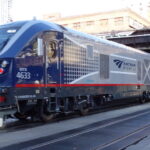A Problem With No Solution?
It happened again the other day. An Amtrak train, traveling at almost 80 miles-per-hour, struck a truck at a private grade crossing north of Fresno, California. There were three people in the truck; all three were killed. No one on the train was injured.
Same old story. It happens almost five times a week on average. Each incident is given lots of publicity in the local and regional media; sometimes nationally. Photos in the newspapers and video for the TV audience don’t seem to make any difference. People continue to drive around the barriers despite the clanging bels and flashing lights. Or, in this most recent incident, apparently failing to “stop, look and listen” since this was a private crossing with no barriers … no bells … and no flashing lights.
The railroad industry got together with law enforcement some 35 years ago and launched Operation Lifesaver—basically designed to raise awareness of the problem—and it worked in those early days. In 1981, there were 728 people killed and almost 3300 people injured in grade crossing accidents. For the next 20 to 25 years, there was a slow, steady drop in the numbers. But then, for the past ten years or so, those numbers have stabilized: roughly 250 people killed and about 900 others injured every year.
“Every 90 minutes someone in this country is hit by a train. A train, okay? Trains are on tracks; they can’t come and get you. They can’t surprise you when you step off the curb. You have to go to them.” —George Carlin
I’m sorry to say it, but there doesn’t seem to be a solution to the problem. There are something like 140,000 grade crossings in the U.S. and about half have some kind of warning system: flashing lights, bells and gates. But that means roughly 70,000 grade crossing have only the traditional X-shaped sign, if that.
A complete warning system at a grade crossing can cost a quarter of a million dollars. Let’s imagine that government and industry get together and raise $12 billion dollars to put a warning system at every one of those grade crossings. Would even that help?
I doubt it. Most of the time, these “accidents” occur when someone drives around the gates and past the flashing lights and clanging bell. So there we have it: a problem for which there is no solution. Not even an impractical one.


